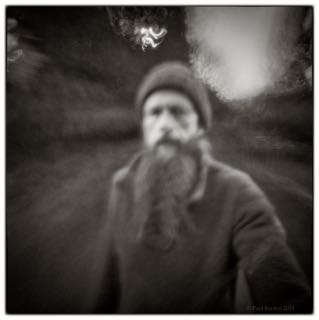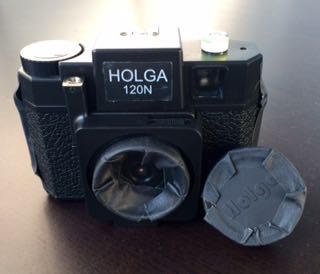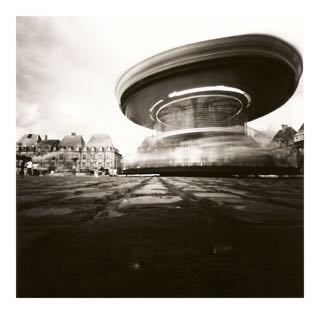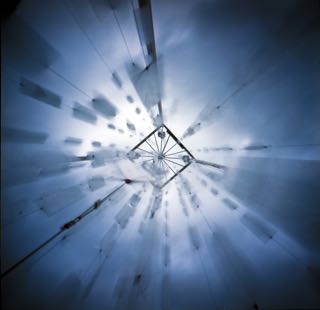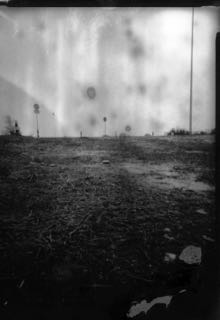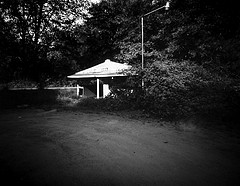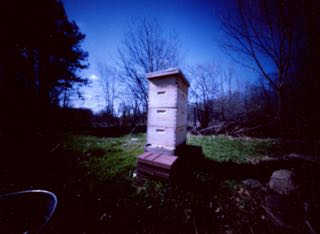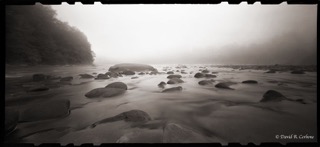Note: all images in this article are ©Paul Barden
[singlepic id=68 w=250 float=right][/singlepic]I first came across Paul’s images while perusing the Flickr Pinhole Photography Group pool. As I scrolled through the page I came across this arresting self portrait, “Walking the Dead”, (right) of a bearded man that had this quality to it that just stopped me in my tracks. I think it’s because, for me, it represented a feeling you get when you’re walking a wilderness or rural area around dusk. Nothing is out of focus, but nothing is clear.
This image drew me to Paul’s work and, as I looked through his images, I found a certain familiarity with my own rural experience. Much of his attention is focused on the rural landscape near his farm – a place that his photos show he obviously knows extremely well. To photograph congested woodlands and mixed agrarian areas, you must have an eye for subtlety. These are not great sky scraping mountains that beckon adventurers from across the globe. No, these are the quiet places – the slow breath – that cannot be consumed in a weeklong vacation, but rather in seasons of wax and wane.
I caught up with Paul over email over the course of a couple weeks, and he was gracious enough to provide some great answers to my questions. Read on to learn about his path in photography, what drives his creativity, his self portraits, and more.
On your blog you mention that you’ve gone through different phases in photography, from film SLR’s to digital. What attracts you to pinhole photography today?
[singlepic id=63 w=250 float=left][/singlepic]My return to working with pinhole technology is just that; a return. In the 1980s I was working with home-made cameras quite a bit as an aspect of my study at the Ontario College of Art (now known as OCADU). However, at that time I didn’t have the luxury of time to devote more than a fraction of my study time to pinhole alone, so it was something I enjoyed a lot but couldn’t invest in heavily at that time.
In 2011 I found myself very dissatisfied with digital imaging technology because I found it was too sterile for my tastes; it lacked a sense of craft. Around 2000, I was enthusiastic to embrace the new sensor-based cameras and set aside my Nikon FM2 for good, and for over a decade my workflow was entirely electronic. But over the years my dissatisfaction grew as I increasingly felt the DSLR was too cold, too impersonal for my liking. There was none of the “alchemy” that traditional silver halide image making offered. I think it’s interesting to see digital photographers so enthusiastic about High Dynamic Range technology, when in fact, film has an incredible dynamic range that you can manipulate with ease. I’ve also come to find importance in the fact that film photography produces a physical object (the negative) whereas what digital image-making produces is ephemeral, and digital files face an uncertain future in a way that film negatives don’t. I’m not suggesting that my negatives are ever going to be of value to anyone but me, but I’m more comfortable with knowing that my negatives have a future that has a proven track record.
My response was to pick up the least advanced silver-based technology I knew, and that was the pinhole camera. Not only did it allow me a chance to revive my traditional skill set, but I felt compelled to experiment once more with hand made cameras of various designs – the wilder, the better!
[singlepic id=60 w=250 float=right][/singlepic]What has pinhole photography helped you to see that you don’t think you would have otherwise?
Pinhole work by its very nature demands that the photographer abandoned certain precepts, which can be very liberating. I am free to make choices at multiple points on the path of crafting a photograph that a digital camera does not permit. (“Farmhouse”, right)
Looking at your pinhole landscapes, one gets the sense that this is a land that is very very familiar to you. Where are you shooting typically? What is your connection to this place?
People who advocate working with film often state that they like working with traditional film technology because it prompts them to “slow down” and exercise greater care in crafting an image. In a similar way, I reject the notion that to create interesting landscape-based work you have to travel far and wide to find worthwhile subject matter. Of course, there are millions of amazing places on this planet to render on film, but I have chosen to restrict myself to a limited palette; most of what I photograph is within walking distance of my home, and in fact, much of my work is done here on the farm, nested in the creases of the Mary’s River. In the same way that film technology places different, less casual demands on a photographer, I find value in exploring my immediate environment – it pushes me to look more closely and carefully at the richness of this home of mine. I have recently found myself saying to people “If you can’t find anything to photograph within forty feet of where you’re standing right now, then you’re just not seeing what’s there.”
[singlepic id=67 w=650]Northeast Riverbed[/singlepic]
What is your workflow process? (e.g. all darkroom? do you scan and use a digital darkroom?)
I do have a darkroom I do my film-related work in, but I do not currently have an enlarger. I process all my film and paper myself, but once I have a negative of some sort, I move to a scanner (an Epson V-750) and from there I process my imagery in Lightroom. I won’t go into detail about my post- processing technique since I’ve discovered in recent times that there are sometimes harsh feelings coming from some of the strictly non-digital practitioners.
I understand the reasoning (and strong emotions) behind the uncompromising “silver only” premise, but I do not care to impose those restrictions on my own creative endeavors. I worked for fifteen years as a professional darkroom technician and spend thousands of hours making prints the traditional way. I decided long ago that I had been exposed to enough print making chemistry for one lifetime and so I embrace the opportunity to make prints in a new way – with inks and dyes on photo rag paper. With all my darkroom experience, I know exactly how I want my prints to look and it’s very easy for me to accomplish my goals with other (non-silver) materials. I see no need to discount new technologies when – for many photographers – they offer an expansion of their creative vocabulary. I think an overly militant “silver only” mindset can be stifling to the creative process, but I do not begrudge the practitioners of this wonderful technology the option of setting limits that are meaningful to their workflow.
[singlepic id=69 w=650]Westview Swale[/singlepic]
Who were your biggest influences in your photographic style?
This is going to seem like an incongruous mix of influences, but…. Minor White. Larry Clarke. Edward Weston. Arno Maggs. Deborah Samuel. Share Corsaut. Miroslav Tichý, Joseph Bryson, Cindy Sherman, April Hickox and numerous friends and acquaintances. I’ve found that many times I’m deeply struck by lone images I encounter, made by people I never encountered before and whose work may be of the most casual sort. Sometimes the simplest candid snapshot reveals more to me than the most carefully planned image might. However, I have recently discovered Gregory Crewdson and find his work very compelling too.
[singlepic id=58 w=650]Access Road[/singlepic]
What is the image that you’re most proud of, that you keep coming back to?
I find that difficult to answer, honestly. My emotional response to individual pieces changes from day to day – month to month. I see my work through the lens of shifting goals and unsettled process. I used to think that it was important to arrive at a clearly defined goal before you set out to start a body of work, but for me, that imposes limitations that I’m not comfortable with. I think it’s more valuable to explore possibilities unencumbered by “goal” and “intent” and discover the connections between certain pieces through editing and selecting a body of work. Sometimes you can’t see what you’ve been doing until you’ve completed it.
However, recent pieces I’ve done with extended sensitivity films (infrared emulsions) have become very meaningful to me, partly because there is a nostalgic component to working in this style – I shot 35mm Kodak HIE a lot back in the 1980s and enjoyed it immensely for its altered tonality and spooky feel.
[singlepic id=66 w=650]North Riverbed[/singlepic]
I’m finding recent panoramic landscapes done on Rollei Infrared 120 roll film very appealing, with their gently skewed horizons and peculiar tonality. Last fall I did a piece I titled “Glowtree”, which has a strong graphic quality that appeals to me.
[singlepic id=62 w=650]Glowtree[/singlepic]
How do you best deal with creative impediments, such as feeling “blocked” or uninspired to shoot?
I think inspiration comes from doing – its not something that leaps out of your subconscious to set your imagination alight, its something you conjure by taking action. The act of picking up a camera and starting the process often leads to discovery, and discovery – for me – fuels inspiration. Photography is a discovery-based craft, I think.
The photo that brought my attention to your work was, “Walking the Dead”, which appears to be a handheld self portrait. Further, it appears that you’ve done several of these handheld self portraits. I find “Clipper Paul” to be a particularly excellent insight into your context with the landscape you photograph. Can you talk about what led you to try these handheld self portraits and how your experimentation with them has evolved?
[singlepic id=65 w=250 float=right][/singlepic]This started with a series of tests done with a recently acquired camera, the Nopo 6×6 pinhole camera, made in Spain from Walnut, Cherry and other woods. The first test roll produced this image was “Mask of Leaves” (Right)
And from there, I went on to produce the second one of similar intent; “Walking The Dead” (top of article, right), which you referred to. I’ve since decided that this camera is going to be dedicated to pursuing more portraits in this style, but turning more towards creating characters to investigate my state of mind from day to day. (I am thinking this is going to take the form of Totem Animals from the dark brambles of my subconscious! This is where Cindy Sherman is likely to speak to me) I’m thinking of this camera not so much as a camera in the standard sense, but more as a kind of one-eyed diagnostic tool – like a light sensitive divining rod.
It can be very liberating to stop thinking of your tools as defined by their names and titles, and let them take on different roles. I think many pinhole photographers do this to some extent. I mean, its exciting to transform an old cookie tin into a camera that you can use to produce viable, exciting imagery.[singlepic id=70 w=250 float=right][/singlepic]I’m quite pleased with my Big Cookie Tin pinhole image I produced for World Pinhole Day this year (April 26, 2015) (right). I originally made this camera for making Solargraphs. (I did make one four-month exposure during the winter) For WPD I loaded it with an 8X10 sheet of Ilford Delta 100, which was the first time I’ve worked with film that size! (Expensive stuff, at $4.50 a sheet) I had to sit for 29 minutes to get that exposure, and I am very pleased to find that Delta has excellent latitude, which helped compensate for the fact that the film plane varied in distance from the pinhole. I’m excited to use the old Cookie Tin 8X10 with Ilford’s Delta 100 again soon.
I should mention that a significant part of the enjoyment for me is making the camera. I have some excellent cameras made by skilled people (my Clipper 3D printed camera, and my 6X17 Vermeer by Cezary Bartczak are both excellent cameras), and I’m very pleased to work with my home-printed copy of Todd Schlemmer’s Pinh5ad 4×5 camera but my Zero Image cameras get used less and less often, because in a way they are less personal and certainly less quirky than some of my other cameras. For me, the Zero Image was a great starter pinhole camera when I bought it in 2012, but I soon felt the desire to make odd cameras to my own specifications. (I think Miroslav Tichý was guiding my hands at that point!)
The Zero Image cameras (and the Nopo and the Ondu, etc.) are excellent devices, and the fact that there are so many clever designers making them in recent years is very encouraging and suggests that film photography has entered a kind of renaissance period. It seems that it was inevitable that it would reach this point. If you look at the history of photographic techniques and materials, its been a cycle of new technology replacing older materials, and eventually the obscure, older technology is discovered by a new generation of artists and it explodes into a wave of renewed enthusiasm. I see plenty of young photographers who were “born digital” discovering silver-based photography and they are experiencing it not as I am – as someone returning to familiar territory – but as newborns discovering a strange and magic realm for the first time, and for them, its pure alchemical magic. Thats a very exciting shift to see happening. It makes me very hopeful that film technology will be around for a long, long time.
[singlepic id=59 w=650]Clipper Paul [/singlepic]
You have two images, “Fireflies” and “Judy Goes Walking”, for which your experimentation takes a a slightly different direction. Can you talk about your process for these images?
[singlepic id=61 w=450 float=right][/singlepic]The “Fireflies” (right) panorama is a proof of concept piece that predates the piece titled “Judy Walking” (below). “Fireflies” was shot using my Clipper 6X17 panoramic curved-plane camera designed and 3D-printed by Clint O’Connor (pinholeprinted.com). Exposing for about 15 minutes at dusk, I experimented with a Vivitar flash unit, aiming it at the camera from about 15 feet and firing it manually, then moving my position and repeating the process. The idea was to determine to what degree the flash would make a usable exposure, and what kind of mark it would leave.
From there, I moved to my Zero Image 4X5 pinhole camera to expand on the idea. In making “Judy Walking”, I first exposed the riverbed scene at dusk for about ten minutes using the pinhole “lens”, then closed the dark slide on the film holder, removed the film holder, switched the “lens” to the Zone Plate, replaced the film holder and made a new exposure after dark.[singlepic id=64 w=400 float=right][/singlepic] The “figures” in the image are an empty translucent dish detergent bottle illuminated by multiple firings of the flash unit. The Zone Plate lends the glowing quality to the image.
Thematically, “Judy Walking” is a re-envisioning of a photo I made in the mid-1980s in art college. It is talking about how we anthropomorphize manufactured objects – specifically addressing my memories of a dressmakers form – called a “Judy” – my Mother used for her clothing alteration jobs when I was a child. This piece also reflects my appreciation for the locomotion studies of Edward Muybridge and superficially, it echoes the aesthetic quality of some of his wonderful work.
Many thanks to Paul for subjecting himself to the ƒ/D interview process! Got more questions for him? Feel free to put them in the comments below. If you’d like to stay tuned to Paul’s ongoing work, he can be found on Twitter, Flickr and his personal blog.
